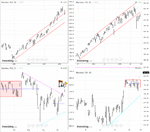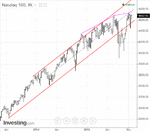dbphoenix
Guest Author
- Messages
- 6,954
- Likes
- 1,266
The "century" number thing has been discussed for decades. But it's an easy hook, most convenient for those who don't use charts, who are after all those who move markets (see yesterday's posts). Consider also our relationship to the July high.
But I found it interesting this morning that today's high and yesterday's high were identical, making the calculation of the DP simple. Once one has that, all he has to do is decide how much risk he's willing to assume and then assume it. Having done that, he'd have four hours to enter at that price before price dropped to 64.
Other than that, given all the meandering, my position is neutral.
Db
But I found it interesting this morning that today's high and yesterday's high were identical, making the calculation of the DP simple. Once one has that, all he has to do is decide how much risk he's willing to assume and then assume it. Having done that, he'd have four hours to enter at that price before price dropped to 64.
Other than that, given all the meandering, my position is neutral.
Db


